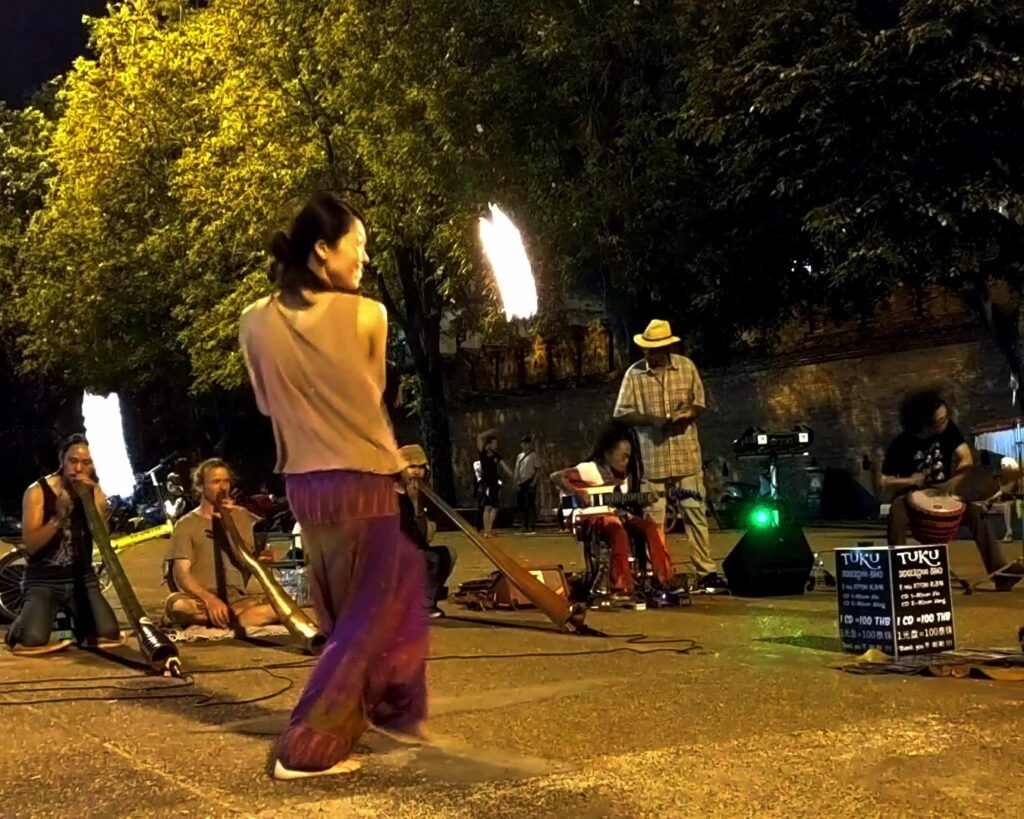
Chiang Mai has a lot of temples! There are over 300 in the city and its outskirts and 30 of those are just within the Old City. In roughly the center of the Old City lies Wat Chedi Luang, which is one of Chiang Mai’s most important temples. Also known as The Temple of the Great Stupa or Jedi Luang, it used to house the most sacred object in Thailand, the Emerald Buddha. It was eventually moved and now resides in the Grand Palace in Bangkok, which we saw earlier in our trip. To commemorate the 600th anniversary of the chedi, a black jade reproduction of the Emerald Buddha was placed in one of the four niches on the eastern side of the pagoda.
The chedi was built between the 14th and 15th centuries and was at least 80 meters tall, making it the largest structure in Chiang Mai at the time. But at some point, it was heavily damaged either by an earthquake or cannon fire used to regain the city from the Burmese. In the 1990s, the chedi was partially restored. However, the top wasn’t restored because no one really knows what it used to look like.
Other noteworthy structures on the grounds include the main Viharn hall that houses the principal Buddha image Phra Chao Attarot, and the city pillar, Sao Inthakin, which is the city’s guardian spirit protecting it from evil and disaster. Unfortunately, women are not allowed to enter the pillar because they are considered unclean since they menstruate. There is a large gum tree outside of the city pillar that also helps protect the city, and it’s said that if the tree ever falls, so will Chiang Mai.
You also have the opportunity to chat with monks here to learn about their ways, and in return, help them with their English. We didn’t do this our first time in Chiang Mai but were able to do so when we returned in November 2018, and it was great!
One of the best things to do in Chiang Mai is to simply walk around the Old City visiting all of the temples. There are way too many to see in one day so you should plan your route before heading out and start early, which unsurprisingly, we did not. We found a useful site that gave an efficient route with a Google Map to follow: https://www.bigboytravel.com/asia/thailand/chiangmai/freewalkingtour/. Therese really liked it cause it also provides a little bit of information about each stop.
We walked most of the tour, but we did grab a songthaew between the Hua-Lin corner section of the wall and Wat Phra Singh. So if you want to visit as many sites as possible, you may want to consider renting a bicycle, starting early and finishing late or just break it up into multiple days.
We didn’t do everything listed, but we did manage to do the majority of it. The temples shown in this post include Wat Chiang Man (Temple of the Fortified City), Wat Hua Kuang (or Wat Saen Muang Ma Luang), Wat Kun Kha Ma (Golden Horse Temple), Wat Phra Singh (Temple of the Lion Buddha), Wat Chai Phra Kiat (Temple of the Renowned Victory), Wat Phan Tao (Monastery of a Thousand Kilns), and Wat Phan On, as well as the Fallen Child Statue outside of Chiang Mai’s police station.
We especially liked the Chedi Chang Lom, which translates to tower “Surrounded by Elephants”, at Wat Chiang Man, the ornate details at Wat Hua Kuang, the Lion Buddha statue and Buddhist monk replicas at Wat Phra Singh, and the teak wood Sermon Hall at Wat Phan Tao.
Continuing on our Chiang Mai walking tour, the temples shown in this post include Wat Hua Kuang (or Wat Saen Muang Ma Luang), Wat Ratcha Montien (or Wat Ratchamonthian or Wat Rajamontean – Dragon Temple), Wat Lok Moli (or Wat Lok Molee), Wat Phra Singh (Temple of the Lion Buddha), Wat Tung Yu, and Wat Phan Tao (Monastery of a Thousand Kilns), as well as the Janghuarinnakorn mansion (the House of Success).⠀⠀⠀⠀⠀⠀⠀⠀⠀⠀⠀⠀ ⠀⠀⠀⠀⠀⠀⠀⠀⠀⠀⠀⠀⠀⠀⠀⠀⠀⠀⠀⠀⠀⠀
We were especially interested in the extent of the complex at Wat Hua Kuang, the huge seated Buddha statue overlooking the main road at Wat Ratcha Montien, the giant three-tiered brick chedi with a signed saffron cloth at Wat Lok Moli, the Wat Phra Singh complex (many postcards of Chiang Mai depict the golden chedi with the Ordination Hall (Ubosot) on the right and the gilded Sermon Hall (Lai Kham Viharn) on the left), and the life-sized wax monk figures at Wat Tung Yu. Wat Phan Tao is where we watched the beautiful ceremony of monks lighting paper lanterns during the Yi Peng (Yee Peng) Festival in November 2018.
After spending almost two weeks in Chiang Mai, it was time to move south to all of Thailand’s amazing islands. But little did we know that we would be back later in the year to celebrate the Lantern Festival. From the moat and wall surrounding the Old City, temples, street markets, eclectic music, food, and fun day trips, Chiang Mai has a little something for everyone and should not be missed! Hopefully, you will get to see a Tuku Didgeridoo Band street performance – they are awesome! Also, try to check out the Cowboy Hat Lady at the Chang Phuek Night Market as seen in an old Anthony Bourdain Parts Unknown episode.
Gallery
Details
Dates Visited:
- May 18, 2018















